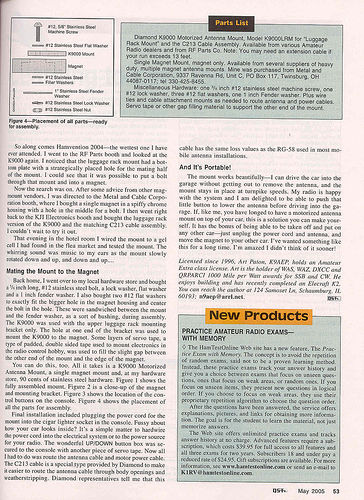
This video shows a few ways that you can monitor your ham radio transmitter with an oscilloscope. Look at the RF carrier, the carrier envelope, the amplitude demodulated signal, as well as linearity “trapazoid” patterns (please see below). It shows a simple circuit I put together for a local ham radio club meeting and presentation. I put this circuit together to show the radio club members examples of a sampler and a amplitude demodulator. Of course, since these were built onto the same “demonstrator” board with a common RF input, the linearity can not be measured with this since any non-linearity in the output would appear in both sensors. This is indicated by the notes in the video. In order to truly measure the non-linearity of an amplifier or a modulator/exciter, the X-input would normally be driven by the baseband signal, or the demodulated input to an amplifier, etc., and the RF output would be sensed with the sampler and applied to the Y input of the scope.
Video Rating: 4 / 5



Glad you liked it!
Great video. One of the most helpfull & useful I have found on Youtube for Ham Radio.
73’s DE K3ZW
Thank you Paul - I’m glad that you enjoyed it!
Great video there, i am getting my shack done up and gone get my test equipment out and vids like this are good to see and give me ideas thanks, how would you couple a 2 tone signal for 2 seprate generators when checking flat top in SSB ?
You can typically use a resistive summer/divider circuit to combine the two tones from the two generators, and reduce their amplitude to a few mV to couple properly to the MIC input of your radio.
This method of generating a trapezoid pattern WILL NOT indicate linearity of the modulated stage, only the linearity of the diode detector. To check modulation linearity, you must sample the audio directly from the modulator and use that sample to deflect along the X-axis. With plate modulation, use a resistive voltage divider off the modulated +HV line to the final amplifier, along with a DC blocking capacitor and additional phase shift correction capacitors across the resistors as needed.
Of course. To check the linearity of a modulator, you use XY to look at the baseband audio vs. the modulated output. To look at the linearity of an RF amplifier, you can use the diode detector on the exciter output (X) and sample the amplifier (Y). The video doesn’t show either of these specifically, as the comments on the video indicate. The video was intending to show how to use XY, recognizing that this jig won’t show linearity b/c both detectors are coupled to the same source.
john, great explanation you are a genius mate could you possibly do a video on how a car key fob works how to program etc .
please keep the vids coming, john
How critical are the 1N34A diodes. I can’t seem to find them locally. I hate to pay $7.00 shipping for two diodes that are worth $1.00 each. Can I substitute 1N4003 for example?
Germanium diodes like the 1N34A are best for this, but you can also use Silicon switching diodes such as a 1N914 or 1N4148 with decent results. The output will just be a bit more non-linear. A power diode like the 1N4000 series really wouldn’t have sufficient switching time to work well in this application.
Neat!
Great video explanation. Thank you for sharing this knowledge. N2QPP
Did I hear you say 1000 “puff” capacitor? Has to be the first time I’ve heard that in all the time I’ve done and taught electronics. Used to hearing picofarad and it hit me odd. I’ve had a similar box made up for about 30 yrs, something I built from an old ARRL or other source schematic and similar to the breakout boxes we had for missile radar in the AF. Good video.
Yep – you heard me say “puff” when referring to pF. Maybe it’s a local thing – but it’s been a common term in the 30yrs or so that I’ve been involved…
Hahaha I’ve never heard it referred to like that. Guess that’s why they say you come across new things everyday no matter how long you’ve been around, BTW have you considered mounting that into a metal box to contain and shield the RF. I know you only use it for short periods but an aluminum project box would keep you from RF exposure and eliminate and radiation to other equipment in the direct area.
I’ve built some in the past in metal boxes. I built this one as a demonstration aide for a talk a gave to a local radio club. That’s why it was built in the “open”, and it’s why the sampler and demodulator are attached to the same RF signal, something you’d never do if you wanted to make real linearity measurements.
im looking for information on rf carrier waves, im building a rife generator that introduces emf frequencys on a cellular level, these were invinted in the 50s and proven to cure cancer. but were denied by fcc, because of use of rf carrier waves on a 2.4mhz frequency, and im working to find a alternative carrier … what would be used to produce the rf carrier, and to adjust the frequecy of them
Really not sure what you mean by alternative carrier. There are many RF signal generators available to create signals. They can generate RF signals at any desired frequency within the limits of the unit.
Im needing something that I can transmit a carrier wave, at 2.4 hz, that I can use to send tone frequencies . I need to operate around 100 decibel and keep the wattage low enough to not cause physical damage in proximity im guessing around 100-200 watts.
This is terrific and very clear. Thank you for this! I’m going to make this tonight. 73, K6JEB
“Puff” is what we’ve used here since I first heard the term back in 1959 (got my Novice ticket). The term is still widely used today as well.
Thanks for directing me to this video re my question on how to scope both the RF and the demod signals. Now I can go play with my scope and the old antique SigGen to figure out what the heck is going on. These are just great educational material in a very practical way, priceless**:-)
Rama
Have you thought about selling a kit? I’d but one. Thanks for the video.
I’m glad you enjoyed the video. I have been asked before about making kits for this as well as my D104 microphone preamp. But, I prefer to simply provide all of the information for others to build themselves. For this circuit, it should really be built into two separate units so that it could properly be used for linearity measurements.
Nice vid, thanks, Sure is a nice scope, locks right on to the signal.
DAVE W4GSM